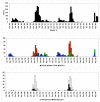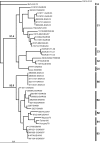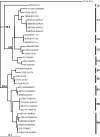Sentinel surveillance for human enterovirus 71 in Sarawak, Malaysia: lessons from the first 7 years
- PMID: 16827926
- PMCID: PMC1543637
- DOI: 10.1186/1471-2458-6-180
Sentinel surveillance for human enterovirus 71 in Sarawak, Malaysia: lessons from the first 7 years
Abstract
Background: A major outbreak of human enterovirus 71-associated hand, foot and mouth disease in Sarawak in 1997 marked the beginning of a series of outbreaks in the Asia Pacific region. Some of these outbreaks had unusually high numbers of fatalities and this generated much fear and anxiety in the region.
Methods: We established a sentinel surveillance programme for hand, foot and mouth disease in Sarawak, Malaysia, in March 1998, and the observations of the first 7 years are described here. Virus isolation, serotyping and genotyping were performed on throat, rectal, vesicle and other swabs.
Results: During this period Sarawak had two outbreaks of human enterovirus 71, in 2000 and 2003. The predominant strains circulating in the outbreaks of 1997, 2000 and 2003 were all from genogroup B, but the strains isolated during each outbreak were genetically distinct from each other. Human enterovirus 71 outbreaks occurred in a cyclical pattern every three years and Coxsackievirus A16 co-circulated with human enterovirus 71. Although vesicles were most likely to yield an isolate, this sample was not generally available from most cases and obtaining throat swabs was thus found to be the most efficient way to obtain virological information.
Conclusion: Knowledge of the epidemiology of human enterovirus 71 transmission will allow public health personnel to predict when outbreaks might occur and to plan interventions in an effective manner in order to reduce the burden of disease.
Figures




References
-
- Grist NR, Bell EJ. Enteroviruses. In: Weatherall DJ, Ledingham JGG and Warrell DA, editor. Oxford Textbook of Medicine. Oxford, Oxford University Press; 1996.
-
- Melnick JL. Enteroviruses: polioviruses, coxsackieviruses, echoviruses and newer enteroviruses. In: Fields BN, Knipe DM, Howley PM, Chanock RM, Melnick JL, Monath TP, Roizman B and Strauss SE, editor. Field's Virology. 3rd. Philadelphia, Lippincott-Raven Publishers; 1996.
-
- Schmidt NJ, Lennette EH, Ho HH. An apparently new enterovirus isolated from patients with disease of the central nervous system. J Infect Dis. 1974;129:304–309. - PubMed
-
- Lindenbaum JE, Van Dyck PC, Allen RG. Hand, foot and mouth disease associated with coxsackievirus group B. Scand J Infect Dis. 1975;7:161–163. - PubMed
-
- Alexander JPJ, Baden L, Pallansch MA, Anderson LJ. Enterovirus 71 infections and neurologic disease--United States, 1977-1991. J Infect Dis. 1994;169:905–908. - PubMed
Publication types
MeSH terms
Substances
Grants and funding
LinkOut - more resources
Full Text Sources

